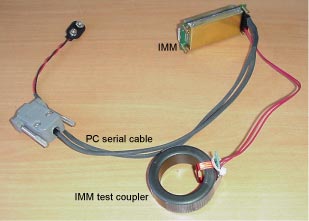APPLICATION NOTE NO. 78
Inductive Modem Module (IMM) Quick Start
Instructions
September 2005

 Print
version
Print
version
This document assumes the user has a Sea-Bird Electronics
Surface Inductive Modem (SIM) with tone detect and an
Inductive Cable Coupler
(ICC).
The IMM is shipped in Configuration Mode 7, ready to connect
to a PC with a terminal program.
- Connect the PC serial cable and IMM Test Coupler to the
IMM at J1 and J2.
- Connect the PC serial cable to a PC serial port. Run
Seaterm or another terminal program. If using Seaterm, select
Configure/SBE 37, and on the COM Settings tab select RS-232 mode. Select
the appropriate COM port at 9600 baud, 8 bits, no parity, 1 stop bit.
Select no flow control if using a terminal program other than Seaterm.
- Apply power to the SIM and connect it to a different PC
serial port. Run Seaterm or another terminal program. If using Seaterm,
select Configure/SBE 37, and on the COM Settings tab select RS-232 mode.
Select the appropriate COM port at 9600 baud, 8 bits, no parity, 1 stop
bit. Select no flow control if using a terminal program other than
Seaterm. The terminal program displays an S> prompt when you press Enter.
|
 |
- Connect the SIMís Inductive Cable Coupler (ICC) to the
SIM. Connect a loop of wire through the IMM Test Coupler and the ICC to
simulate the Inductive Mooring Cable.
- Connect a 9-volt battery to the IMM. The terminal
program displays an IMM> prompt when you press Enter.
|
 |
The test setup is now complete. The remaining instructions are
an introduction to IMM operation.
Note: Commands are not case sensitive.
- The IMM cannot communicate with the Inductive Mooring and
the Host at the same time [1]. The terminal
program with the IMM> prompt serves as host in this setup. When power is
applied to the IMM, the IMM immediately sends a prompt to the Host
[2]. At the IMM> prompt, type PwrOff and press
Enter. This terminates the host service and allows the IMM to respond to
commands from the Inductive Mooring Cable.
- The SIM does not transmit to the IM line until it receives
the PwrOn command. At the S> prompt, type PwrOn and press Enter
to start transmitting. The IMM automatically detects the signal from the SIM
and starts listening to the IM line.
- At the S> prompt, type ID? and press Enter. The IMM
responds via the IM line.
- The IMM Device ID should be 00. At the S> prompt, type
!00GetSD and press Enter to send the status command (get Status Data).
Similar commands are GetHD (get Hardware Data) and GetCD (get
Configuration Data).
- In addition to its ID, the IMM may be addressed by its
serial number by inserting an S and the serial number before the command. Type
!S70000002GetSD (where 70000002 is the IMM serial number) and press
Enter. This addressing method works for all commands starting with ! or
#.
- In the IMM terminal program, press Enter. The IMM> prompt
returns.
- Only one device can transmit to the IM line at a time. At
the IMM> prompt, type GetLineStatus and press Enter. The IMM detects
the signal from the SIM, does not attempt to transmit, and reports that the
line is busy. Type CaptureLine and press Enter. The IMM again reports
that the line is busy.
- At the S> prompt, type PwrOff and press Enter to
turn off the SIM transmitter.
- At the IMM> prompt, type CaptureLine and press
Enter. If the electrical environment is noisy, the IMM may report that the
line is busy. If this happens, use ForceCaptureLine to start
transmitting unconditionally.
- At the IMM> prompt, type
TestCableCoupler and press
Enter. This checks that the cable coupler is properly installed and not
damaged. This command works only when the line is captured.
- At the IMM> prompt, type SendWakeupTone and press
Enter. This activates the SIMís tone detect feature.
- At the IMM> prompt, type ReleaseLine and press
Enter. This disables the IMM transmitter. Type PwrOff and press Enter
to put the IMM to sleep. The IMM now listens for commands from the SIM.
- At the S> prompt, type PwrOn and press Enter to
enable the SIM transmitter.
- At the S> prompt, type #00TEST and press Enter. This
sends the string TEST to the IMMís host. The IMM sends a return
character (\r) to the terminal program, waits a few moments, then sends
the IMM> prompt followed by the string TEST. Then the IMM relays
characters from the terminal program to the SIM until Enter is pressed or a
timeout occurs.
- The \r character serves hosts that require a
transition on the serial line to wake-up (like most Sea-Bird RS-232
instruments). The \r character transmission may be disabled with the
SetEnableSerialHostWakeup=0 command, and re-enabled with the
SetEenableSerialHostWakeup=1 command. Note that the IMM requires you to
enter the command twice to verify.
- The IMM> prompt received before the TEST string and
before any commands may be disabled with the SetEnablePrompt=0 command,
and re-enabled with the SetEnablePrompt=1 command. Note that the IMM
requires you to enter the command twice to verify.
Footnotes:
[1]
The IMM will soon be able to send a busy signal to the host when it is
processing IM commands and vice versa.
[2] This is true in the current
configuration, but the Host Service on Powerup can be disabled.

Last modified:
23 Feb 2011
Sea-Bird Home Phone: (+1) 425-643-9866
Fax: (+1) 425-643-9954 E-mail:
seabird@seabird.com
![]()


![]()